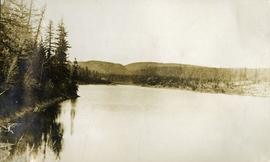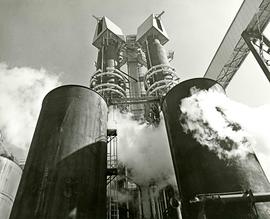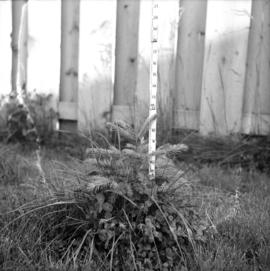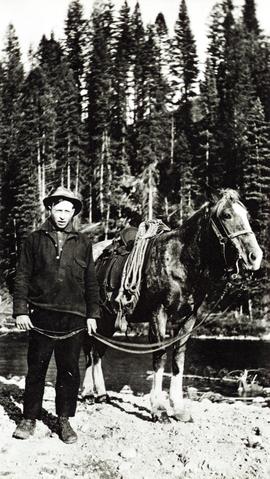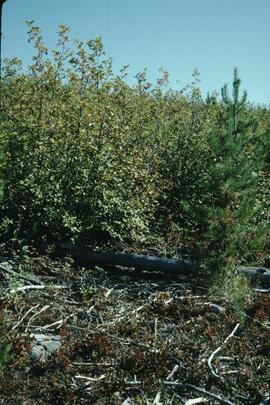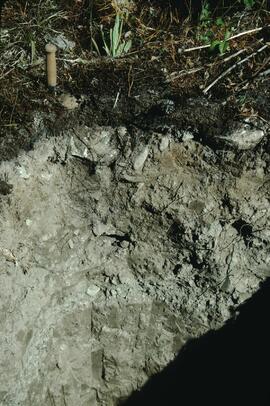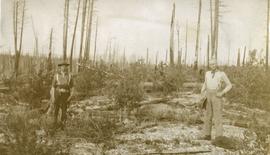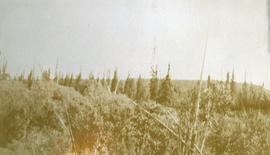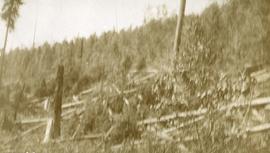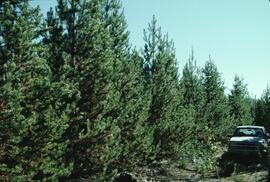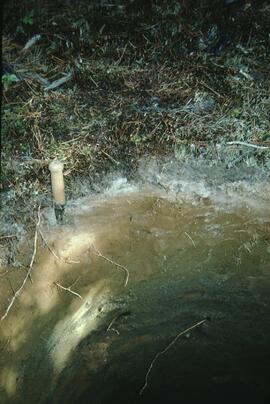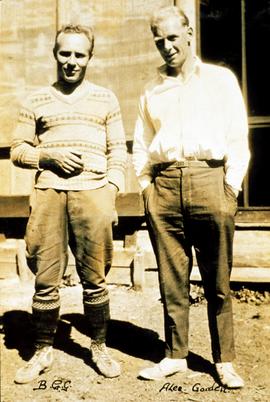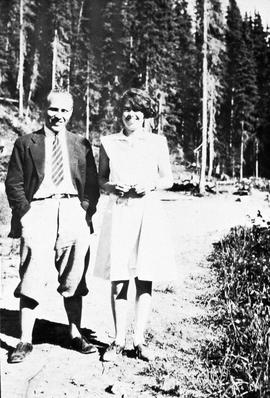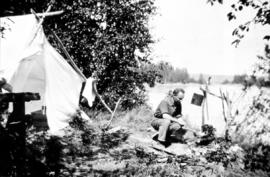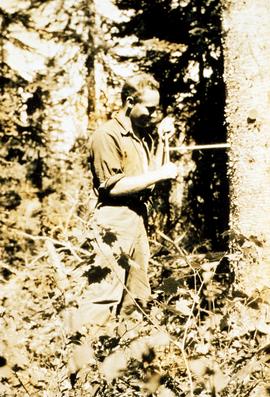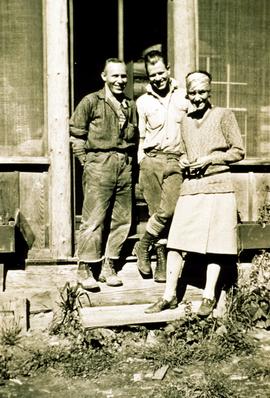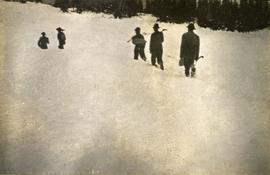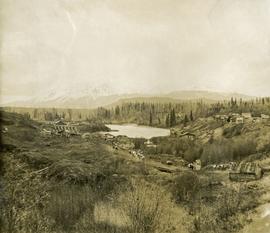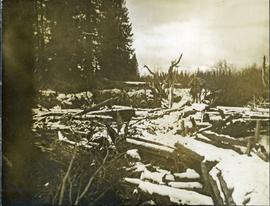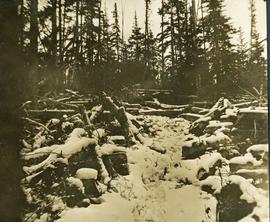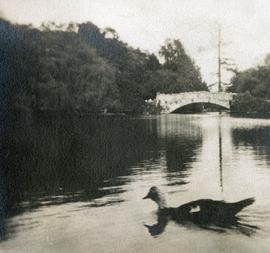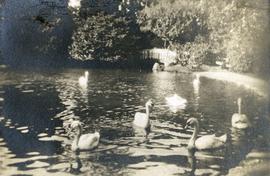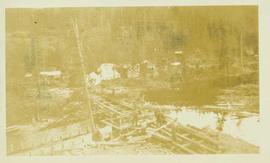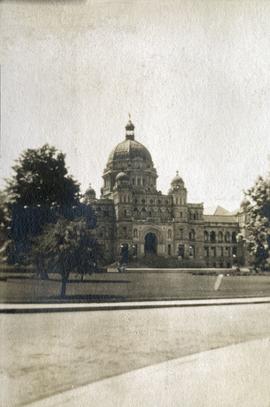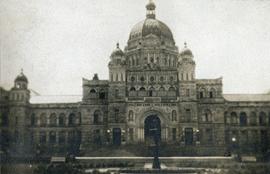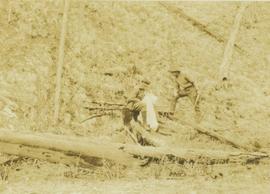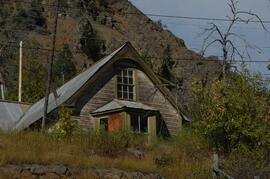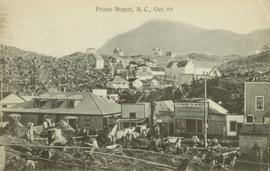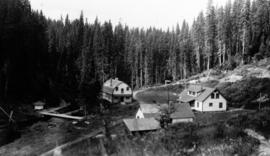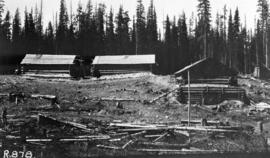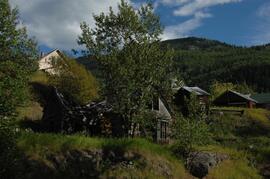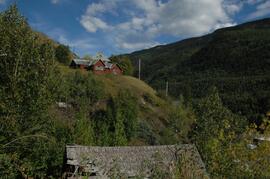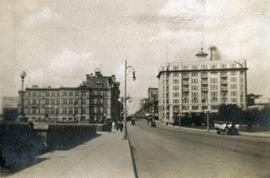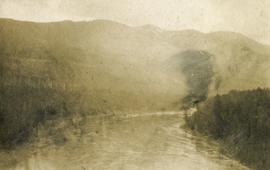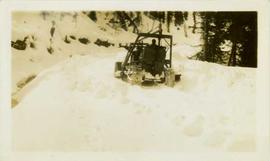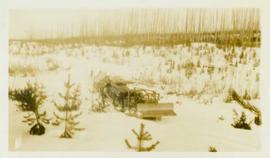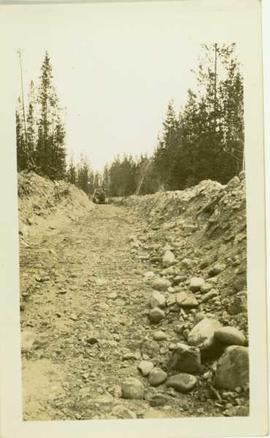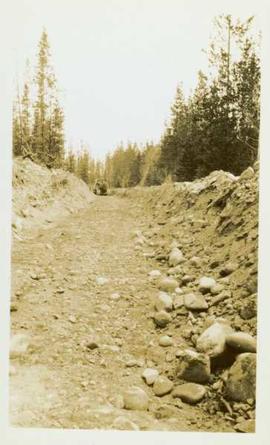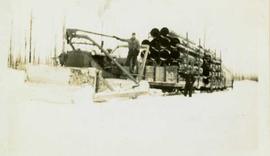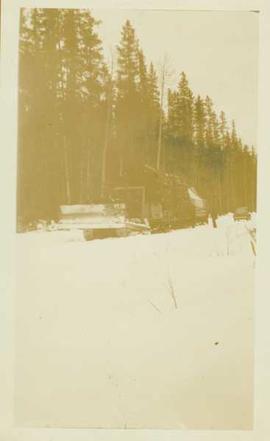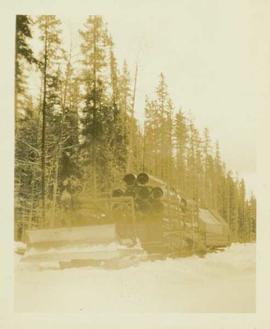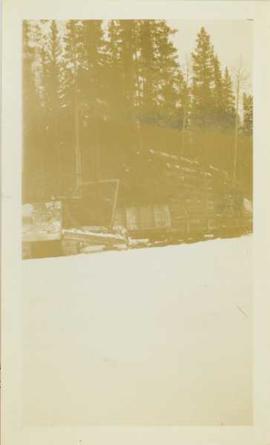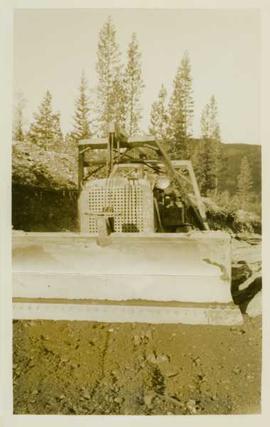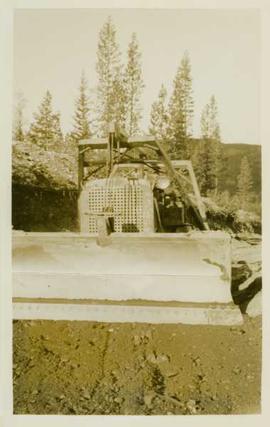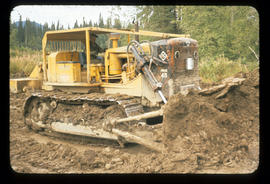Photograph depicts a body of water surrounded by sparsely forested hills and low mountains.
Photograph depicts the Blackwater bridge and cabin. The forest in the foreground has been roughly cleared.
Photograph depicts a large body of water the shore edged with forest and low hills.
Attached description: The two black tanks in the foreground are blow tanks for the two Kamyr digesters which tower behind them. This picture, taken from ground level, shows graphically the 210-foot height of the digesters. Chip conveyors lead in from the right. Each digester is served by a separate conveying line, providing flexibility in the type of wood used, and also ensuring that operation of one digester can continue.
Caption describing photograph: "Excellent form and growth of a blue form of White Spruce wildling. Transplanted Autumn 1964 from 10 miles South of Findlay Forks on Parsnip River. Height 13.5", 1966 growth to date 4.2", Hardened off."
Item is a photograph of a copy print, resulting in a low quality photographic reproduction. Reproduced as a print, slide, and a negative. Location of original photograph is unknown.
Bob St. Claire was an American forester who came to BC with an MF degree and some experience in the US Forest Service. He was familiar with the US Forest Experimental Stations. In 1923, as Assistant Chief Forester, he wrote a report recommending: 1) a research station centred in Victoria, and 2) an experiment station in each major forest region in the province. His recommendations were followed. In 1924, Aleza Lake Experimental Station was established and in 1929 Cowichan Lake Experimental Station was established. Bob St. Claire was Assistant Chief Forester three times, but never became Chief Forester.
Photograph depicts two men standing in center foreground, forested flat land in background.
Photograph depicts forest growth near Woodpecker Island and Stone Creek.
Photograph depicts forest growth with fallen trees and remnants of a forest fire.
Item is a photograph of a copy print that has been reproduced as a slide, resulting in low photographic quality. Location of original photograph unknown.
Alec Gordon was a soil specialist who conducted land use surveys separating forest land from potential agricultural land.
Item is a photograph of a copy print that has been reproduced as a slide, resulting in low photographic quality. Location of original photograph unknown.
"After we made the acquaintance of several girls living in Aleza Lake village, they would be invited to come to the camp on a Sunday to enjoy the music. Social events were infrequent, so they did not complain about having to travel three miles by rail and then walking another three-quarters of a mile on a foot trail that was sometimes quite muddy." -- from An Early History of the Research Branch, British Columbia Ministry of Forests and Range (p. 48)
Item is a photograph of a copy print that has been reproduced as a slide, resulting in low photographic quality. Location of original photograph unknown.
Item is a photograph of a copy print that has been reproduced as a slide, resulting in low photographic quality. Location of original photograph unknown.
Item is a photograph of a copy print that has been reproduced as a slide, resulting in low photographic quality. Location of original photograph unknown.
Photograph depicts A cluster of boats anchored on the edge of a stream, some men standing on shore. Photograph is dark and blurry.
Photograph depicts a bow of a boat in the foreground. Thick ice on the edges of the river, water with floating ice beyond the boat. Trees lines the shoreline.
Photograph depicts five men carrying shovels, walking through the snow in single file.
Photograph depicts a view of a small bridge and dirt road joining buildings on two sides of a river. Loaded packhorses are traveling down the road. There are mountains in the distance. Survey of 55th parallel.
Photograph depicts a rustic bridge covered in snow leading across a log jam. A horse is walking on the bridge toward the photographer. [55th parallel]
Photograph depicts a trail through log jam built by survey party. [55th parallel]
Photograph depicts the bridge at Goodacre Pond in Beacon Hill in Victoria, BC. Duck in foreground.
Photograph depicts the bridge at Goodacre Pond in Beacon Hill in Victoria, BC. Swans are swimming in the pond and there is a path and footbridge behind the pond.
Photograph depicts eight men building a wooden bridge over a section of lake. A mining (?) work camp is visible in a foreseted background.
Photograph depicts the British Columbia Parliament Buildings in Victoria, BC.
Photograph depicts the British Columbia Parliament Buildings in Victoria, BC.
Photograph depicts the British Columbia Parliament Buildings in Victoria, BC.
Photograph depicts Bruce Otto, a hunting guide, standing next to Prentiss Gray, who is seated on a stump skinning his prized mountain goat.
Photograph of Prince Rupert businesses amidst clear cut stumps. Businesses include "Stewart and Mobley Groceries, Fruits and Produce." Printed annotation on recto reads: "Prince Rupert, B.C., Oct. 09."
Photograph copy print contains the following writing on verso:
British Columbia Archives and Records Service Visual Records Unit
Negative No. H-5387
GR 1348
B.C. Forest Service : The Young Men's Forestry Training Plan
September 1, 1935
Photographer's photo number R878. No caption on back of photograph to glean further information. Title provided based on contextual information from related photographs and documents.
Photograph depicts buildings looking north of the Empress Hotel on Douglas Street in Victoria, BC. The Belmont is on the right and the Customs Building on the left.
Photograph depicts a view looking down on the Bulkley River, forested banks on both sides of the river, high mountains in the distance.
Photograph depicts a person operating a bulldozer to clear a path through the snow in a forested landscape.
Photograph depicts a bulldozer convoy freighting supplies into camp in winter.
Photograph depicts a bulldozer driving down a shallow ditchline with a forested area in the background.
Photograph depicts a bull dozer driving down a gravel road through a forested landscape.
Photograph depicts a bulldozer in a winter landscape pulling sleds loaded with large pipes and steel drums potentially heading for the mines for assembly.
Photograph depicts a distance perspective of a bulldozer pulling sleds loaded with large pipes and steel drums potentially heading for the mines for assembly.
Photograph depicts a bulldozer pulling sleds loaded with large pipes and steel drums potentially heading for the mines for assembly.
Photograph depicts a bulldozer pulling sleds loaded with large pipes and steel drums potentially heading for the mines for assembly. Close up of 2004.8.1.57
Photograph depicts the front end of a bulldozer being operated by an unidentified man in front of a forested background.
Photograph depicts the front end of a bulldozer being operated by an unidentified man in front of a forested background.
Slide depicts a bulldozer clearing ground, likely at the Aleza Lake Experiment Station.
